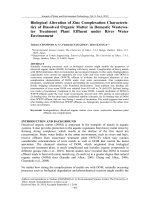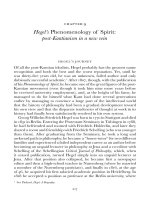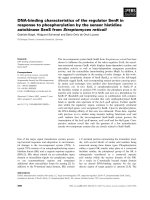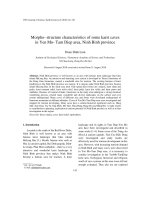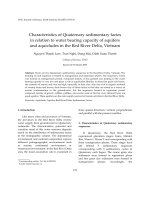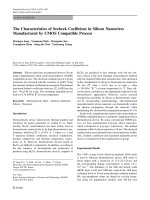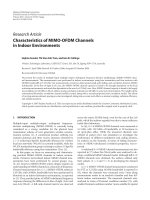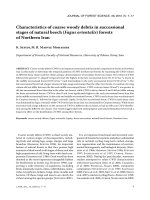Ecophysiological characteristics of ectomycorrhizal ammonia fungi in hebelomatoid clade
Bạn đang xem bản rút gọn của tài liệu. Xem và tải ngay bản đầy đủ của tài liệu tại đây (9.53 MB, 85 trang )
Ecophysiological characteristics of
ectomycorrhizal ammonia fungi in
Hebelomatoid clade
January 2013
Ho Bao Thuy Quyen
Graduate School of Horticulture
CHIBA UNIVERSITY
(千葉大学学位申請論文)
千葉大学学位申請論文)
Ecophysiological characteristics of
ectomycorrhizal ammonia fungi in
Hebelomatoid clade
2013 年 1 月
千葉大学大学院園芸学研究科
環境園芸学専攻生物資源科学コース
環境園芸学専攻生物資源科学コース
Ho Bao Thuy Quyen
Contents
Page
Contents ......................................................................................................................... I
List of Tables .............................................................................................................. IV
List of Figures ...............................................................................................................V
Acknowledgements .................................................................................................... VII
Abstract ....................................................................................................................... IX
General Introduction .................................................................................................. 1
Chapter 1. The first record of Hebeloma vinosophyllum (Strophariaceae) in
Southeast Asia ........................................................................................ 6
Introduction .............................................................................................. 6
Materials and Methods ............................................................................. 7
Collection ..................................................................................... 7
Observation .................................................................................. 7
Phylogenetic analysis ................................................................... 8
Mating tests .................................................................................. 9
Results .................................................................................................... 10
Taxonomy .................................................................................. 10
Phylogenetic analysis ................................................................. 13
Mating tests ................................................................................ 14
Discussions ............................................................................................ 15
Chapter 2. Ability of ectomycorrhization of late phase fungi in Hebelomatoid
clade ....................................................................................................... 17
Introduction ............................................................................................ 17
Materials and Methods ........................................................................... 18
Organisms .................................................................................. 18
Mycorrhizal colonization ........................................................... 19
Results .................................................................................................... 21
Fungal growth and fruiting ability ............................................. 21
I
Growth of seedlings ................................................................... 21
Ectomycorrhization .................................................................... 21
Discussions ............................................................................................ 27
Chapter 3. Photo-response of fruit body formation in ectomycorrhizal ammonia
fungi Alnicola lactariolens and Hebeloma vinosophyllum ................. 28
Introduction ............................................................................................ 28
Materials and Methods ........................................................................... 29
Pre-cultivation ............................................................................ 29
Effect of light on fruit body formation of Alnicola lactariolens
and Hebeloma vinosophyllum .................................................... 29
Statistical analysis ...................................................................... 30
Results and Discussions ......................................................................... 30
Responses of fruit body formation in Alnicola lactariolens to
different light intensities ............................................................ 30
Responses of fruit body formation in Hebeloma vinosophyllum to
different light intensities ............................................................ 33
Responses of fruit body formation in Alnicola lactariolens and
Hebeloma vinosophyllum to different light periods ................... 36
Chapter 4. The
effects
of
ammonium-nitrogen
and
nitrate-nitrogen
concentrations on fruit body formation in ectomycorrhizal ammonia
fungi Alnicola lactariolens and Hebeloma vinosophyllum ................. 38
Introduction ............................................................................................ 38
Materials and Methods ........................................................................... 39
Pre-cultivation ............................................................................ 39
Effect of ammonium-nitrogen and nitrate-nitrogen concentrations
on fruit body formation of Alnicola lactariolens and Hebeloma
vinosophyllum ............................................................................ 39
Results and Discussions ......................................................................... 40
Growth and reproductive responses of Alnicola lactariolens to
ammonium-nitrogen and nitrate-nitrogen concentrations .......... 40
II
Growth and reproductive responses of Hebeloma vinosophyllum
to ammonium-nitrogen and nitrate-nitrogen concentrations...... 42
Chapter 5. The absorbing abilities of cesium and coexisting elements in an
ectomycorrhizal ammonia fungus Hebeloma vinosophyllum ........... 44
Introduction ............................................................................................ 44
Materials and Methods ........................................................................... 45
Results and Discussions ......................................................................... 47
The uptake of cesium and coexisting elements by Hebeloma
vinosophyllum ............................................................................ 47
The effect of NH4+ concentrations on the cesium, potassium and
phosphorus uptake by Hebeloma vinosophyllum ....................... 50
General Discussions .................................................................................................. 55
Literature Cites ......................................................................................................... 60
III
List of Tables
Page
Table 1. Collection details of specimens and cultures in the phylogenetic
analysis
9
Table 2. Published sequences in the phylogenetic analysis
10
Table 3. Dikaryon-monokaryon mating tests between dikaryotic stock cultures
of Japanese Hebeloma vinosophyllum and monokaryotic strains of
Vietnamese Hebeloma sp.
15
Table 4. Fungal isolates of LP hebelomatoid fungi used to investigate ECM
association
19
Table 5. Responses of fruiting in Alnicola lactariolens to different light
intensities
31
Table 6. Responses of fruiting in Hebeloma vinosophyllum to different light
intensities
34
Table 7. Days required for fruit body formation of Alnicola lactariolens and
Hebeloma vinosophyllum to different light exposure periods per day
37
Table 8. Days required for the fruit body initiation of Anicola lactariolens and
final pH of media after harvesting fungal biomass
40
Table 9. Days required for the fruit body initiation of Hebeloma vinosophyllum
and final pH of media after harvesting fungal biomass
42
Table 10. Concentrations and chemical forms of Cs and coexisting elements (K,
Ca, Mg, Zn, Cu, Fe and P) in the medium
46
Table 11. Concentrations of K in media added different concentrations of NH4+
46
Table 12. Concentration (mg/kg dry sample) of Cs, K, Ca, Mg, Zn, Cu, Fe and P
in mycelium and fruit bodies of Hebeloma vinosophyllum
48
Table 13. Translocation of Cs, K, P, Ca, Mg, Fe, Zn and Cu in Hebeloma
vinosophyllum from mycelium to fruit bodies
49
IV
List of Figures
Page
Fig. 1.
Hebeloma vinosophyllum.
12
Fig. 2.
Hebeloma vinosophyllum from the urea plot in Vietnam
12
Fig. 3.
Biogeographic distribution of Hebeloma vinosophyllum in Japan
(Honshu: Saitama, Tochigi, Tokyo, Chiba, Shiga, Shizuoka, Kyoto,
Tottori; Shikoku: Kochi and Kyushu: Oita, Miyazaki), South Korea,
China (Fujian Province) and Vietnam (Da Lat)
13
Fig. 4.
The maximum likelihood phylogenetic tree based on ITS data set (A) and
LSU data set (B) of Hebeloma vinosophyllum and allied species.
14
Fig. 5.
The fruit body formation of LP hebelomatoid fungi in the association
with Pinus densiflora
22
Fig. 6.
The fruit body formation of LP hebelomatoid fungi in the association
with Quercus serrata
22
Fig. 7.
The hyphal colonization of LP hebelomatoid fungi in roots of Pinus
densiflora
23
Fig. 8.
ECM between Alnicola lactariolens and Quercus serrata
24
Fig. 9.
ECM between Hebeloma vinosophyllum and Quercus serrata
25
Fig. 10. ECM between Hebeloma aminophilum and Quercus serrata
26
Fig. 11. Effect of light intensity on the morphology of mature fruit bodies in
Alnicola lactariolens
32
Fig. 12. Effect of light intensities on fruit body formation in Alnicola lactariolens
33
Fig. 13. Effect of light intensity on the morphology of mature fruit bodies in
Hebeloma vinosophyllum
35
Fig. 14. Effect of light intensities on fruit body formation in Hebeloma
vinosophyllum
36
V
Fig. 15. Effect of different concentrations of diammonium sulfate on vegetative
growth and fruit body formation of Alnicola lactariolens
41
Fig. 16. Effect of different concentration of potassium nitrate on vegetative
growth and fruit body formation of Anicola lactariolens
41
Fig. 17. Effect of different concentration of diammonium sulfate on vegetative
growth and fruit body formation of Hebeloma vinosophyllum
43
Fig. 18. Effect of different concentration of potassium nitrate on vegetative
growth and fruit body formation of Hebeloma vinosophyllum
43
Fig 19. The transfer factors of Cs, K, P, Ca, Mg, Fe, Zn and Cu in Hebeloma
vinosophyllum biomass (mycelium and fruit bodies)
48
Fig 20. The transfer factors of Cs, K and P in Hebeloma vinosophyllum biomass
(mycelium and fruit bodies) under different NH4+ concentrations
50
Fig. 21. Fruit body formation of Hebeloma vinosophyllum in different NH4+
concentrations
51
Fig. 22. Dry biomas of Hebeloma vinosophyllum (mycelium and fruit bodies) in
different NH4+ concentrations
52
Fig. 23. The ratios of Cs and K concentrations in mycelium and fruit bodies of
Hebeloma vinosophyllum in different NH4+concentrations
53
Fig. 24. The supposed successive occurrence in the field of LP hebelomatoid
fungi
57
Fig. 25. The potential application of Hebeloma vinosophyllum as bioremediation
in the control of radiocessium in forest systems
58
VI
Acknowledgements
I would like to send the deepest gratitude to Prof. Akira Suzuki, Graduate School
of Horticulture, Chiba University, Chiba, Japan, my supervisor, for the best support to
my scientific ideas and works. He and his wife, Ms. Tomoko Suzuki, also helped me
so much for adapting with life in Japan.
I would like to send a deep gratitude to
•
Dr. Kiminori Shimizu (Medical Mycology Research Center, Chiba
University, Chiba, Japan) who is always kind with me and taught a lot of
knowledge about biomolecular works to me.
•
Dr. Satoshi Yoshida (National Institute of Radiological Sciences, Chiba,
Japan) who provided the facilities and taught methods of element
measurement in mushroom samples to me.
•
Dr. Toshimitsu Fukiharu (Natural History Museum and Institute, Chiba,
Japan) who helped and taught the fungal morphology in this research to me.
•
Dr. Takashi Yamanaka (Forest and Forest Products Research Institute,
Tsukuba, Japan) who provided seeds and seedlings of oaks.
•
Dr. Hisayasu Kobayashi (Ibaraki Prefectural Forestry Research Institute,
Ibaraki, Japan) who provided seeds of pines.
•
Dr. Naohiko Sagara (Prof. Emeritus of Kyoto University, Kyoto, Japan)
who provided the fungal isolate.
The other deep gratitude would like to be sent to
•
Medical Mycology Research Center, Chiba University, Chiba, Japan
•
National Institute of Radiological Sciences, Chiba, Japan
•
Natural History Museum and Institute, Chiba, Japan
•
Forest and Forest Products Research Institute, Tsukuba, Japan
and
•
Prof. Susumu Kawamoto, Medical Mycology Research Center, Chiba
University, Chiba, Japan
•
Prof. Ken-ichi Tozaki, Faculty of Education, Chiba University, Chiba,
Japan
VII
•
Prof. Hiromi Hamada, Faculty of Education, Chiba University, Chiba,
Japan
•
Prof. Chihiro Tanaka, Kyoto University, Kyoto, Japan
for the help to develop my research in doctoral dissertation.
I also want to send the thanks to Prof. Tatsuaki Kobayashi, Prof. Kazunori
Sakamoto, Dr. Seigo Amachi for their suggestions to improve my doctoral
dissertation.
My doctoral dissertation was also supported by the below budgets
•
The doctoral fellowship of Ministry of Education and Training, Vietnamese
Government, Vietnam in fiscal year 2009 – 2012
•
The AGGST program for students, Chiba University, Chiba, Japan in fiscal
year 2011 – 2012 and fiscal year 2012 – 2013 for expanding my research
In the end, I want to send the deepest gratitude to my parents, my husband, my son,
my great family and all of my friends in Vietnam, in America and in Japan who
always was behind and encouraged me in any time.
VIII
Abstract
During a survey of ammonia fungi in southern Vietnam, specimens belonging to
Hebeloma section Porphyrospora Konr. & Maubl. ex Vesterh. were collected. Fruit
bodies of Hebeloma sp. were occurred on two urea-plots in a pine (Pinus kesiya)
forest, Da Lat City, Lam Dong Province, Vietnam. Based on morphology, molecular
phylogeny and mating compatibiliy, the specimens were identified as Hebeloma
vinosophyllum Hongo. This is the first record of H. vinosophyllum in Southeast Asia
and of H. vinosophyllum occurring in P. kesiya forests, one of two dominant pines in
Southeast Asia.
In vitro associations between Alnicola lactariolens, H. vinosophyllum or H.
aminophillum, and P. densiflora or Quercus serrata were established to attain the
clear evidents of their ectomycorrhizal abilities. After 16 weeks of incubation, the
colonization of fungal mycelia of three species was observed in some parts of P.
densiflora roots. However, the development of Hartig net was not observed.
Otherwise, the associations between A. lactariolens, H. vinosophyllum, or H.
aminophillum, and Q. serrata showed ectomycorrhizal characteristics with mantle and
Hartig net.
The effect of light on fruit body formation in A. lactariolens and H.
vinosophyllum was examined in vitro without host plants. Fruit body initiation of A.
lactariolens and H. vinosophyllum was accelerated by light irradiation. Both fungi
required light for their fruit body maturation. Light more drastically affected the
morphology of fruit bodies, especially stipe length than fruiting time, number of fruit
bodies and biomass of fruit bodies in both ectomycorrhizal fungi. H. vinosophyllum is
less sensitive than A. lactariolens to photo-morphogenesis.
The effect of ammonium-nitrogen and nitrate-nitrogen on fruit body formation
in A. lactariolens and H. vinosophyllum was investigated. A. lactariolens formed fruit
bodies on ammonium sulfate, but did not form fruit bodies on potassium nitrate. The
range of ammonium sulfate that effected to fruiting was 0.138–1.38 g N/L at pH 7.
The dry weight of mycelium was higher than that of fruit bodies. Days required for
the fruit body initiation was 31–43 days. H. vinosophyllum formed fruit bodies on
both ammonium sulfate and potassium nitrate. The concentration range of ammonium
IX
sulfate and potassium nitrate for fruiting of H. vinosophyllum were 0.046–1.38 g N/L
and 0.046–0.138 g N/L, respectively. On concentration range of ammonium sulfate
0.138–0.46 g N/L, dry weight of fruit bodies was higher than that of mycelium
1.7–2.7 times. Days required for the fruit body initiation on ammonium sulfate were
9–16 days while those on potassium nitrate were 64–65 days. These results indicated
that ammonium-nitrogen was more effective nitrogenous source for fruit body
formation of A. lactariolens and H. vinosophyllum than nitrate-nitrogen,
When cultivated in the Ohta’s liquid medium added cesium chloride with
different concentrations of ammonium sulfate, H. vinosophyllum absorbed cesium and
coexisting elements (K, Ca, Mg, Zn, Cu, Fe and P) with high transfer factors. The
highest translocation from mycelium to fruit body was observed in Cs among 8
analyzed elements. The uptake of Cs might have a similar pattern to that of K and P.
However, the high concentration of NH4+ might affect as the competitor to the uptake of
both Cs and K, but not to the uptake of P. The addition of NH4+ affected more the
uptake of Cs than that of K.
In conclusion, some ecophysiological characteristics of ectomycorrhizal ammonia
fungi in Hebelomatoid clade providing the possible explanation about their successive
occurrence in the field were obtained in this study. It is expected that A. lactariolens
and H. vinosophyllum are excellent model organisms for further researches of
ectomycorrhizal fungal ecophysiology and bioremediation of radiocesium.
X
General Introduction
General Introduction
Definition of ammonia fungi
“Ammonia fungi” are defined as a chemoecological group of fungi that
sequentially develop reproductive structures exclusively or relatively luxuriantly on
soil after a sudden addition of ammonia, of other nitrogenous materials that react as
bases by themselves or on decomposition, or of alkalis (Sagara 1975). The sequential
appearance of reproductive structures (succession) of these fungi generally follows as
the scheme: anamorphic fungi
ascomycota
smaller basidiomycota
larger
basidiomycota (Sagara 1975).
Ammonia fungi can be divided into two groups based on their succession in the
field. One group comprises species that appear in the early phase in the succession
(EP fungi; anamorphic fungi
ascomycota
smaller basidiomycota) while those of
the second group appear in the late phase of the succession (LP fungi; larger
basiodiomycota) (Sagara 1995; Yamanaka 1999, 2003; Imamura & Yumoto 2004;
Immamura et al. 2006). All EP fungi are saprobic (saprotrophic) (Yamanaka 1999,
2003), mostly litter decomposing fungi as speculated based on their observed litterdecomposing abilities (Enokibara et al. 1993; Yamanaka 1995a; Soponsathien 1998a,
b). Otherwise, most LP fungi are biotrophic and are characterized as ectomycorrhizal
symbionts (Sagara 1995).
Biogeographic distribution of ectomycorrhizal ammonia fungi in Hebelomatoid
clade
The survey of ammonia fungi by the urea application in the field and/or
laboratory started from Japan (Sagara & Hamada 1965) and extended to New Zealand,
Europe, North America, Taiwan and Australia (Sagara 1992; Sagara et al. 1993;
Fukiharu et al. 1997a; Wang & Sagara 1997; Suzuki et al. 1998, 2002a; Nagao et al.
2003). Most LP fungi such as Alnicola lactariolens Clémeson & Hongo [syn.:
Anamika lactariolens (Clémençon & Hongo) Matheny], Hebeloma aminophilum R.N.
Hilton & O.K. Mill, H. luchuense Fukiharu & Hongo, H. radicosoides Sagara, Hongo
& Murak., H. spoliatum (Fr.) Karst., H. vinosophyllum Hongo, Laccaria amethysina
1
General Introduction
Cooke, L. bicolor (Maire) Orton sensu Imazeki & Hongo and Suillus bovinus (Pers.)
Roussel were characterized as ectomycorrhizal fungi (Sagara 1992, 1995; Yamanaka
1995b, c; Fukiharu & Hongo 1995; Fukiharu et al. 1997b; Sato & Suzuki 1997;
Suzuki et al. 1998, 2002b; Suzuki 2000, 2009a; Imamura & Yumoto 2004; Sagara et
al. 2008). Among these LP fungi, Hebemoma species and A. lactariolens belonging to
Hebelomatoid clade (Moncalvo et al. 2002, Yang et al. 2005) and Laccaria species
seem to be common members (Suzuki et al. 2003).
In the Northern Hemisphere, H. luchuense, H. radicosoides and A. lactariolens
have been collected from Castanopsis and Quercus forests after urea application
(Sagara 1975, 1992, 1995; Suzuki 1992; Clémençon & Hongo 1994; Fukiharu &
Hongo 1995; Fukiharu & Horigome 1996; Fukiharu et al. 1997a; Shimabukuro 2000).
H. vinosophyllum has also been collected from urea plots of Castanopsis, Quercus,
and Pinus forests (Sagara 1975, 1992, 1995; Yamanaka 1995c; Fukiharu & Horigome
1996; Fukiharu et al. 2000a, b).
A. lactariolens has been obtained from the central part of Honshu Island, Japan
to Taiwan (Clémençon & Hongo 1994, Fukiharu & Hongo 1995, Fukiharu et al.
1997a, Shimabukuro 2000) while H. radicosoides is known from the central part of
Honshu Island in the temperate region of Japan to Iriomote Island in the subtropical
region of Japan (Fukiharu & Hongo 1995, Sagara et al. 2000, Shimabukuro 2000,
Suzuki 2000). H. vinosophyllum has been record from Japan (Sagara 1975, 1976a,
1992, 1995; Yamanaka 1995c; Fukiharu & Horigome 1996; Fukiharu et al. 2000a, b;
Suzuki 2000; Kasuya 2002), China (Hongo et al. 1996; no deposition of voucher
specimen – personal information by Dr. Kinjyo), and possibly in South Korea (Lee
2011; species name listed without any original references). H. luchuense is known
only from the subtropical Okinawa and Iriomote Islands (Fukiharu and Hongo 1996,
Shimabukuro 2000).
H. spoliatum (Fr.) Karst. has been collected from Quercus and Fagus forests
with a large amount of ammonium-nitrogen presence (Sagara 1975, 1992, 1995;
Suzuki 1992, 2000; Fukiharu & Horigome 1996; Sato & Suzuki 1997; Shimabukuro
2000, Suzuki et al. 2002b). H. spoliatum has been recorded from various sites in both
the Northern and Southern Hemispheres (Suzuki et al. 2003), but the host plant was
not shown in the collection record from Central Africa (Bresadola 1981).
2
General Introduction
In the Southern Hemisphere, H. aminophilum has been collected from temperate
regions of New Zealand and from temperate to tropical regions of Australia; namely
from the North Island, in New Zealand; near Perth, Western Australia, south-eastern
Victoria, Tasmania and northern Queensland, in Australia (Hilton 1978, Miller &
Hilton 1987, May & Wood 1997, Suzuki et al. 1998, Young 2002, Suzuki et al. 2003).
H. aminophilum also occurred on urea plots in Nothofagus forests in the North Island,
New Zealand and in Eucalyptus forests near Perth, Western Australia (Suzuki et al.
1998, Suzuki et al. 2003).
It seems that most Hebeloma species and Alnicola lactariolens of ammonia
fungi have the strong host specificity and their biogeographic distribution likely
restricted by the distribution of host plants.
Physiology of ectomycorrhizal ammonia fungi in Hebelomatoid clade
Basidiospore germination of H. vinosophyllum is stimulated by 0.1–100 mM
ammonia aqueous solution (Suzuki 1978). Optimum for the spore germination of H.
vinosophyllum by NH4Cl aqueous solution is 100 mM at pH 8.0 (Deng and Suzuki
2008a). Optium for basidiospore germination of another ectomycorrhizal LP fungus H.
spoliatum by NH4Cl is 100 mM at pH 8.0 (Suzuki 2009b). The optimum temperature
of the spore germination in H. vinosophyllum and H. spoliatum are 25oC (Deng and
Suzuki, 2008a) and 15oC (Suzuki 2009b), respectively. Spore longevity of H.
vinosophyllum and H. spoliatum (Deng and Suzuki 2008a, Suzuki 2009b) gradually
decreases in the increment of storage period. Exposing to dry condition makes spore
longevity shorter than wet condition. It is expected that in the field, the basidiospores
of H. vinosophyllum and H. spoliatum would survive for at least 5 months and 2 years,
respectively (Suzuki 2006, Suzuki 2009a, b).
Ectomycorrhizal ammonia fungi show optimum vegetative growth at pH 5 or 6
(Yamanaka 2003). H. vinosophyllum and H. radicosoides grow well in both inorganic
nitrogen sources such as NH4Cl, KNO3, KNO2 and organic nitrogen sources such as
L-asparagine and urea (Yamanaka 1999). In the vegetative growth of H.
vinosophyllum, pH optimum for ammonium-nitrogen is pH 7–8 whereas that for
nitrate-nitrogen is pH 5–6. When comparing biomass of the vegetative growth of H.
vinosophyllum for ammonium-nitrogen at pH 7–8 and that for nitrate-nitrogen at pH
3
General Introduction
5–6, the former is larger than the latter (Suzuki 2006). Assimilation of nitrite-nitrogen
is also reported in the cultivation of H. vinosophyllum in a synthetic medium adjusted
at pH 7–8 (Suzuki 2006). H. vinosophyllum and H. aminophilum have vegetative
growth maxima at around 0.003–0.1 M NH4Cl. The upper limit concentration of
NH4Cl for their vegetative growth is 0.6 M (Licyayo and Suzuki 2006).
The major nitrogen form several days after the urea-treated soils is ammoniumnitrogen. Ammonium-nitrogen gradually changes into nitrate-nitrogen and reaches
maximum concentration at around the period of the first flush of LP fungi (Yamanaka,
1995a, b; Suzuki et al. 2002b). The change in pH, concentrations of ammoniumnitrogen and that of nitrate-nitrogen are as follows: pH and ammonium-nitrogen
concentration rapidly increase just after urea application and then gradually decrease
during the occurrence period of both EP and LP fungi. These results indicate that the
major nitrogen source for vegetative growth of ammonia fungi would be ammoniumnitrogen irrespective of their nutritional modes under neutral to weakly alkaline
conditions, and nitrogen sources utilized by the ectomycorrhizal ammonia fungi
would gradually replaced from ammonium-nitrogen to nitrate-nitrogen associated
with the decline of pH in the urea-treated soil.
H. vinosophyllum, H. spoliatum, and A. lactariolens fruit on a nutrient-rich
medium such as MY agar medium or a synthetic agar medium (Suzuki 1979, 1988,
2006, 2009a, b, 2012a, b; Fujimoto et al. 1982; Deng & Suzuki 2008a; Barua 2012).
Monokaryotic fruiting was reported in H. vinosophyllum (Deng & Suzuki 2008b).
Ectomycorrhizal ammonia fungi in the late phase, therefore, proposed as facultative
mycorrhizal fungi.
Goals of this study
Although the examination of ammonia fungi following application of urea in the
field and/or laboratory conducted from 1965 until now (Sagara & Hamada 1965;
Sagara 1973, 1975, 1976b, c, 1992; Suzuki 1987, 2000, 2006, 2009a, b; Yamanaka
1995a-c; Fukiharu & Hongo 1995; Sato & Suzuki 1997; Wang & Sagara 1997;
Imamura 2001; Suzuki et al. 2002a, b, 2003; Nagao et al. 2003; Imamura & Yumoto
2004, 2008), distribution records of ammonia fungi are fragmentary at a global scale
(Sagara 1992; Sagara et al. 1993; Fukiharu et al. 1997a; Wang & Sagara 1997; Suzuki
4
General Introduction
et al. 1998, 2002a, 2003; Nagao et al. 200; Fukiharu 2011, 2012; Raut et al. 2011, Ho
et al. 2012). Hence, the urea was applied to the floor of a Pinus kesiya forest in Lam
Dong Province, Vietnam and the first record of an ectomycorrhizal ammonia fungus
H. vinosophyllum Hongo in Southeast Asia was reported in Chapter 1.
Until recent, Hebeloma spp. and Alnicola lactariolens in LP fungi were reputed
as ectomycorrhizas based on their genera habit. Despite of some studies done
(Fukiharu 1991, Fukiharu & Hongo 1995, Sagara 1995, Imamura & Yumoto 2008),
reports of ectomycorrhiza in LP fungi lack morphological description in vitro and
molecular evidence. On the other hand, their in vitro fruiting abilities (Suzuki 1979,
1988, 2006, 2009a, b, 2012a, b; Fujimoto et al. 1982; Deng & Suzuki 2008 a, b; Barua
2012) marked a question about their ectomycorrhizal abilities. Therefore, in vitro
ectomycorrhizal associations were established in Chapter 2 between the hosts P.
densiflora and Quercus serrata with three LP species A. lactariolens, H.
vinosophyllum and H. aminophilum.
In Chapter 3 and Chapter 4, the effects of light and nitrogen sources on the
fruit body formation of A. lactariolens and H. vinosophyllum were investigated to
elucidate the basic information related to the fruit body formation of the
ectomycorrhizal fungi in pure culture without host plants, and in the field.
In Chapter 5, the uptake and accumulation of cesium and coexisting elements
in H. vinosophyllum mycelium and fruit bodies under the competition of ammonium
cation were investigated in the model of cultivation in liquid medium. The results
would contribute not only to the bioremediation of radiocesium in the field but also to
elucidate the absorbing abilities of different kinds of essential elements by
ectomycorrhizal fungi.
By the results from all our above researches, we hope that many discoveries of
the ecophysiological characteristics of ectomycorrhizal ammonia fungi would be
obtained and help us in more understanding the mechanism of the successive
occurrence of ammonia fungi in the field.
5
Chapter 1
Chapter 1
The
first
record
of
Hebeloma
vinosophyllum
(Strophariaceae) in Southeast Asia
Introduction
Hebeloma vinosophyllum Hongo was originally described by Hongo (1965)
from Japanese specimens and was initially considered to be an endemic species
confined to Japan. This species was reported to be similar to H. sarcophyllum in
having a light brown to purplish red spore print but differing from H. sarcophyllum
(Peck) Sacc. in the shape of the hymenial cystidia (Hongo 1965, Singer 1986,
Vesterholt 2005). Sagara (1975) reported H. vinosophyllum as a member of the
“ammonia fungi”, “a chemo-ecological group of fungi that develop reproductive
structures exclusively or relatively luxuriantly on soil after a sudden addition of
ammonia, of other nitrogenous materials that react as bases by themselves or on
decomposition, or of alkalis”. Fruit bodies of H. vinosophyllum were recorded not
only from the forest floor sites augmented with urea but also from soils under natural
disturbance from the decomposition of dead bodies of animals (Sagara 1976a, 1992,
Takayama & Sagara 1981, Fukiharu et al. 2000a, b).
H. vinosophyllum has been recorded from different kinds of vegetation in
various geographical regions of Japan. The fungus has been collected from
Castanopsis, Quercus and Pinus forests (Table 1) in middle and western Honshu
(Hongo 1965; Sagara 1975; Suzuki 1987; Yamanaka 1995c; Fukiharu et al. 1995;
Fukiharu et al. 2000a, b; Kasuya 2002; Imamura & Yumoto 2004, 2008), Shikoku and
Kyushu (Sagara 1975). However, this fungus has not been recorded from certain other
locations in Japan: Hokkaido (urea application in Pinus and Quercus forests; Sagara
1975), eastern Honshu (urea application in Pinus and Quercus forests; Sagara 1975,
Fukiharu & Horigome 1996) and Ryukyu Island (urea application in Castanopsis and
Quercus forests; Fukiharu & Hongo 1995).
Outside Japan, H. vinosophyllum has been recorded from an evergreen oak
forest (Quercus, Castanopsis, Castanea, Cunninghamia, and Pinus, etc.) near
SanMing City, Fujian Province, China (Hongo et al. 1996; no deposition of voucher
6
Chapter 1
specimen – personal information by Dr. Kinjyo), and possibly in South Korea (Lee
2011; species name listed without any original references). Based on these collection
records, H. vinosophyllum appears to have an East Asian distribution (Fukiharu &
Horigome 1996).
During a survey of ammonia fungi in southern Vietnam, specimens belonging to
Hebeloma section Porphyrospora Konr. & Maubl. ex Vesterh (Vesterholt 2005) were
collected. We therefore undertook to identify the Vietnamese specimens based on
morphology, molecular phylogeny, and compatibility between the strains from
Vietnam and stock cultures of H. vinosophyllum from Japan.
Materials and Methods
Collection
The urea-treated plots were established in a Pinus kesiya Royle ex Gordon forest
(more than 30 years old), ca. 1500 m altitude, at Xuan Tho, Da Lat City, Lam Dong
Province, Vietnam. Commercial granulated urea fertilizer at the rate of 600 g/m2 was
applied to 2 plots (1 m × 1 m) on the forest floor. About two months after urea
application, fruit bodies of Hebeloma sp. were observed, collected, and subcultured
onto agar. Cultures were maintained on MY agar medium [malt extract 10 g/L (Difco,
Detroit, USA), yeast extract 2 g/L (Difco, Detroit, USA) and agar 15 g/L (Nacalai,
Japan)] at 20°C in darkness. Fruit bodies were dried at 60oC for 24 h and deposited in
the herbarium of the Natural History Museum and Institute, Chiba, Japan (CBM).
Observation
Morphological characteristics were observed from field specimens, both dry and
fresh. Color notation follows Kornerup & Wanscher (1981).
The microscopic characteristics were observed using differential interference
contrast (DIC) on Labophot-2 (Nikon, Tokyo, Japan) or Olympus B51 (Tokyo, Japan)
microscopes after hand-sectioning and mounting in 10% ammonium hydroxide
aqueous solution. The basidiospores were also observed by scanning electron
microscope (SEM) (Hitachi S-800; Tokyo, Japan) at 15.0 kV after rehydrating in 25%
aqueous ammonia, fixing in 2.5% osmic acid, and coating with platinum-palladium in
an ion sputter-coater (E-1030; Hitachi, Tokyo, Japan). Abbreviations used: Q = mean
7
Chapter 1
length/width ratio measured from “n” number of spores; m = mean spore length and
width.
Phylogenetic analysis
Total nuclear DNA (nDNA) of the dried mycelia and fruit bodies was extracted
from disintegrated tissue using 200 µl 0.5-mm glass beads (Yasui Kikai, Tokyo,
Japan) and 500 µl TES buffer [50 mM Tris-HCl, pH 7.5, 20 mM EDTA, 1% sodium
dodecyl sulfate (SDS)] by vigorous shaking (FastPrep System; mp-Biomedicals,
Solon, OH, USA) at 6.5 m/s for 45 s. Soluble fractions were recovered by
centrifugation. DNA was purified using TE buffer (10 mM Tris-HCl, pH 8.0, 1 mM
EDTA)–saturated phenol/chloroform/isoamyl alcohol (25: 24: 1, Nippon Gene, Tokyo,
Japan) extraction followed by an isopropyl alcohol precipitation. After desiccation of
the DNA pellet, DNA was dissolved in a 30 µl TE buffer. For some samples, genomic
DNA was further purified using NucleoSpin Extract II (Macherey-Nagel, Duren,
Germany), following the manufacturer’s recommendations.
The primer pairs ITS1 and ITS4 or ITS5 and ITS4 (White et al. 1990) were used
to amplify the ITS regions of ribosomal DNA (rDNA). The primers LR0R and LR5
(Vilgalys & Hester 1990) were used to amplify 28S rDNA (large subunit, LSU).
Polymerase chains reactions (PCR) were carried out using KOD FX (Toyobo, Tokyo,
Japan) following the manufacturer’s instructions. PCR products were purified using
NucleoSpin Extract II, and DNA fragments were directly sequenced using the BigDye
Terminator ver3.1 Cycle Sequencing Kit (Applied Biosystems, Foster City, CA,
USA) following the protocol provided. Reactions were cleaned up using the Centri
Sep (Princeton Separations, Adelphia, NJ, USA), before analyzing by capillary
electrophoresis on a 3130x DNA Analyzer (Applied Biosystems). Sequences were
assembled and edited using ATSQ software (Genetyx, Tokyo, Japan) and deposited in
GenBank/EMBL/DDJB (Table 1).
Two data sets were established: LSU and ITS. Each data set included sequences
of Vietnamese specimens, several sequences of Japanese H. vinosophyllum and
sequences downloaded from GenBank (Table 2). The data sets were aligned using
Clustal X ver. 1.81 (Jeannmougin et al. 1998), and the resulting alignments were
manually refined. For phylogenetic analyses, each LSU data set of 892 bp or ITS data
8
Chapter 1
set of 625 bp was analyzed using Tree-Puzzle 5.2 (Schmidt et al. 2002). The
maximum likelihood (ML) tree (Felsenstein 1981) of each data set was inferred based
on quartet puzzling algorithm (Strimmer & Haeseler 1996) with the options of 1000
puzzling steps, model of substitution HKY (Hasegawa et al. 1985).
Table 1. Collection details of specimens and cultures in the phylogenetic analysis
Taxon
Hebeloma
vinosophyllum
Voucher
specimen no.
Isolate no.
Dominant
vegetation
GenBank acc. no.
ITS
LSU
CBM:FB32636*
CBM:FB12306*
CBM-BC69
CBM-BC307
Kyoto, Japan
Chiba, Japan
C. cuspidata
C. sieboldii
AB1742172
AB1742173
AB1742341
AB1742342
CBM:FB12325*
CBM-BC314
Chiba, Japan
AB1742174
AB1742343
CBM:FB12381*
CBM-BC315
Shizuoka, Japan
AB1742175
AB1742344
CBM:FB14335*
CBM-BC337
Miyazaki, Japan
C. sieboldii
Q. acuta, Q.
myrsinaefolia, N. sericea
Q. acuta, N. sericea
AB1742176
AB1742345
CBM:FB14285*
CBM-BC366
Kochi, Japan
AB1742177
AB1742346
CBM:FB14216*
CBM-BC376
Kochi, Japan
Q. phillyraeoides
C. sieboldii, D.
racemosum
AB1742178
AB1742347
AB1742179
AB1742348
CBM:FB14520*
CBM-BC384
Shizuoka, Japan
C. sieboldii, N. sericea,
M. thunbergii
CBM:FB14502*
CBM-BC407
Shizuoka, Japan
Q acuta, N. sericea
CBM:FB15552*
CBM-BC437-3
Kochi, Japan
CBM:FB15553*
CBM-BC438-2
Kochi, Japan
C. sieboldii, D.
racemosum
C. sieboldii, D.
racemosum
C. sieboldii, D.
racemosum
CBM:FB15556*
CBM-BC440-2
Kochi, Japan
CBM:FB24700
CBM-BC533**
Saitama, Japan
AB1742180
AB1742349
AB1742181
AB1742350
AB1742182
AB1742351
AB1742183
AB1742352
AB1742184
AB1742353
AB1742185
AB1742354
AB1742186
AB1742355
Lam Dong, Viet Nam
Al. hirsula, Ca. crenata,
Q. acutissima, Q. serrata,
P. densiflora, S. japonicus
Ab. firma, Q. acuta, Q.
salicina, Q. serrata
P. kesiya
AB1742187
AB1742356
Lam Dong, Viet Nam
P. kesiya
AB1742188
AB1742357
HCMUS-C2
Lam Dong, Viet Nam
P. kesiya
AB1742189
AB1742358
CHU5001*
Western Australia,
Australia
E. marginata, E.
calophylla
AB1742190
AB1742359
CHU5002***
Western Australia,
Australia
E. diversicolor
AB1742191
AB1742360
CBM:FB35472*
Western Australia,
Australia
E. marginata, E.
calophylla
AB1742192
AB1742361
CBM:FB24804
L’Aquila, Italy
Q. cerris
AB1742193
AB1742362
CBM:FB39191*
NBRC107913
Saitama, Japan
CHU4001*
Chiba, Japan
HCMUS-C1
CBM:FB39192*
CBM:FB39267*
Hebeloma
aminophilum
Hebeloma
porphyrosporum
Locality
Basidiomata appeared in urea plot*, around decaying unidentified animal** or around decaying snake***. Ab = Abies, Al = Alnus, C =
Castanopsis, Ca = Castanea, D = Distylium, E = Eucalyptus, H = Hebeloma, M = Machilus, N = Neolitsea, P = Pinus, Q = Quercus, S = Styrax.
Mating tests
The dikaryotic stock culture HCMUS-C2 of Vietnamese Hebeloma sp. was
cultured on MY agar medium, at 20°C, in a light/ dark cycle of 12 hours/ 12 hours
with a white fluorescent lamp (Hitachi, Tokyo, Japan), providing an light intensity at
4.56 µmol m-2s-1. After ca. 3 weeks, in vitro fruit bodies appeared. Then, a small piece
9
Chapter 1
of sterile filter paper was placed under hymenophores of fruit bodies for collecting
basidiospores. The monokaryotic strains were obtained by germination of in vitro
spores.
Table 2. Published sequences in the phylogenetic analysis
GenBank acc. no.
Taxon
Note
ITS
LSU
Hebeloma fastibile
AF325643
AY033139
Hebeloma sarcophyllum
AF124715
Hebeloma vinosophyllum
--03294501
Strain NBRC32945*
AY320398
Boyle et al. 2006**
Alnicola lactariolens
AY818352
AY818353
Anamika angustilamellata
AY575919
AY575919
Anamika indica
AF407163
AF407164
* ITS sequence of strain NBRC32945 was retrieved from DNA resource of Biological Resource
Center, National Institute of Technology and Evaluation, Japan.
** ITS sequence AY320398 was used only for alignment with sequence from Vietnamese H.
vinosophyllum.
Mating tests between monokaryotic tester strains of Vietnamese Hebeloma sp.
and dikaryotic stock cultures of Japanese H. vinosophyllum were examined. Their
mating types were determined by pair-mating with each other. Dikaryotic cultures of
Japanese H. vinosophyllum (isolates CBM-BC69 and CHU4001) were from
collections deposited at the Faculty of Education, Chiba University. The mating tests
were conducted by placing a pair of mycelial discs, one from a monokaryotic tester
strain and the other from a dikaryotic culture, on opposite sides of 90 mm MY agar
plates, incubated at 25°C in darkness and replicated 3 times. After two weeks,
mycelium from the monokaryotic colony was removed from the edge farthest from
the dikaryotic colony and examined microscopically; a compatible crossing was
indicated by the presence of clamp connections.
Results
Taxonomy
Hebeloma vinosophyllum Hongo, J. Jap. Bot. 40: 314-315. 1965
10
Figs. 1–2
Chapter 1
Description based on Vietnamese specimens only: Pileus 20–70 mm broad, at
first hemispherical, then becoming plano-convex to plane; cream to light vinaceous
(7–9A2–3), usually darker at the top; surface glabrescent, smooth, viscid to glutinous
in wet condition; margin at first inrolled and entire, then plane or eroded-undulating,
sometimes still incurved at maturity. Universal veil absent, partial veil fibrillose,
white, dry, at first cortinoid (following Vesterholt 2005), leaving a few fibrils on the
stipe, disappearing with age. Lamellae crowded, 2–4 mm width, 5–30 mm length,
adnexed; pinkish brown (8–9C3–5) to light vinaceous (8–9A3–5) and darker at
maturity. Stipe up to 105 x 15 mm, thickened downward; surface somewhat smooth to
longitudinal striate, floccose-pruinose at the apex; fleshy-fibrous, stuffed at first, then
hollow; cream (7A2–3) to light clay (5D5–6). Context pale white (7–8A2–3); smell
musty; taste weakly bitter. Spore print vinaceous to brownish red (9–10C3–4).
Basidiospores m = 9.7 ± 0.6 × 6.1 ± 0.4 µm [8.4–11.3 × 5.3–7.2 µm, n = 50, Q = 1.59],
amygdaliform to citriform. Basidia 30–40 × 8–9 µm (without sterigmata), clavate,
four-spored; sterigmata 3–5 µm long. Pleurocystidia 48–60 × 8–12 µm, numerous,
ventricose-rostrate to lageniform, narrowly utriform or mucronate. Cheilocystidia
similar to pleurocystidia but less numerous. Pileipellis an ixotrichodermium,
composed of gelatinized cylindrical cells 50–60 µm in length; hypodermium cellular
composed of globose cells 7–9 µm in width.
Habitat: For Vietnamese specimens only: scattered, gregarious or subcespitose
on urea-plots in Pinus kesiya forest, Vietnam, elevation ca. 1500 m, 2 months after
urea application. For worldwide: scattered, gregarious or subcespitose on soil under
Castanopsis, Quercus and Pinus in warm temperate East Asia, usually 6-12 months
after urea application or following the decomposition of dead animal bodies.
Distribution: Japan – middle to western Honshu, Shikoku, and Kyushu; China –
SanMing, Fujian Province; Vietnam – DaLat City, LamDong Province; South Korea –
requires confirmation (Fig. 3).
Specimens examined: VIETNAM. Lam Dong: Da Lat City, Xuan Truong Xuan Tho (UTM, 49P, 023053, 1319015), 24 Jun 2009, B.N Truong (CBM FB39191; culture HCMUS-C1, Faculty of Biology, University of Science, Ho Chi Minh
City, Vietnam); 25 Jun 2009, B.N Truong (CBM FB-39192); 14 Jun 2009, B.N
Truong (CBM FB-39267; culture HCMUS-C2, Faculty of Biology, University of
11
Chapter 1
Science, Ho Chi Minh City, Vietnam). JAPAN. Shiga: Otsu City, Ishizune, 17 Jul
1961, T Hongo (TNS-F-39101, Holotype)
Fig. 1. Hebeloma vinosophyllum. A–D. Hymenial cystidia,
E. Basidiospores. Bar = 10 µm.
Fig. 2. Hebeloma vinosophyllum from the urea plot in Vietnam.
A. Fruit bodies in nature, B: Cortina (partial veil; ∗) of a young fruit body,
C. Scanning electron micrographs of basidiospores, D. Ixotrichodermium
structure of pileipellus. Bar = 3 µm in C, 30 µm in D.
12
Chapter 1
Fig. 3. Biogeographic distribution of Hebeloma vinosophyllum in Japan
(Honshu: Saitama, Tochigi, Tokyo, Chiba, Shiga, Shizuoka, Kyoto, Tottori;
Shikoku: Kochi and Kyushu: Oita, Miyazaki), South Korea, China (Fujian
Province) and Vietnam (Da Lat). ∆ = no deposition of voucher specimen, Ο =
collection site of voucher specimen.
Phylogenetic analysis
Dikaryotic cultures and dried specimens of Vietnamese H. vinosophyllum have
identical molecular sequences in both ITS and LSU regions. The sequence alignment
of dikaryotic cultures of H. vinosophyllum from Japan and dried specimens of H.
vinosophyllum from Vietnam showed similarity of 99.55% (887/891 bp) in LSU data
set and 98.52% (600/609 bp) in ITS data set. The topology of the phylogenetic
analysis (Fig. 4) showed that the dikaryotic cultures and the specimens from Vietnam
were grouped in the same clade as those from Japan; supporting values of 68% in
LSU data set and 86% in ITS data set.
In this study, the holotype specimen of H. vinosophyllum (TNS-F-39101) was
not used for molecular analysis due to its long period of storage with para-
13
